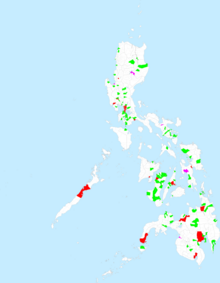| Cities of the Philippines | |
|---|---|

| |
| Category | City (Local government unit) |
| Location | Philippines |
| Number | 149 (as of 2023) |
| Possible status |
|
| Populations | 45,383 (Palayan) – 2,960,048 (Quezon City) |
| Areas | 5.95 km2 (2.30 sq mi) (San Juan) – 2,443.61 km2 (943.48 sq mi) (Davao City) |
| Subdivisions | |
| Cities and municipalities of the Philippines |
|---|
|
 |
|---|
|
|
A city (Filipino: lungsod or siyudad) is one of the units of local government in the Philippines. All Philippine cities are chartered cities (Filipino: nakakartang lungsod), whose existence as corporate and administrative entities is governed by their own specific municipal charters in addition to the Local Government Code of 1991, which specifies their administrative structure and powers. As of July 8, 2023, there are 149 cities.
A city is entitled to at least one representative in the House of Representatives if its population reaches 250,000. Cities are allowed to use a common seal. As corporate entities, cities have the power to take, purchase, receive, hold, lease, convey, and dispose of real and personal property for their general interests; condemn private property for public use (eminent domain); contract and be contracted with; sue; and exercise all powers conferred on them by Congress. Only an act of Congress can create or amend a city charter, and through this charter, Congress confers on a city certain powers that regular municipalities or even other cities may not have.
Despite differences in the powers accorded to each city, all cities, regardless of status, are given a larger share of the Internal Revenue Allotment (IRA) compared to regular municipalities,[a] and are generally more autonomous than regular municipalities.
Cite error: There are <ref group=lower-alpha> tags or {{efn}} templates on this page, but the references will not show without a {{reflist|group=lower-alpha}} template or {{notelist}} template (see the help page).